Running Toronto Waterfront 10K for the Very First Time
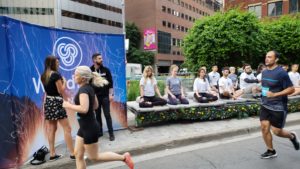
This was my first year running in the Toronto Waterfront 10k, and I will admit that the marketing worked (I am a sucker for branding!). lululemon attaching themselves to this race was a huge draw for me, and seeing the reminders via their instagram account gave me some serious FOMO. Plus: a free lulu running shirt (my running shirt of choice) in your race kit?! YES PLEASE! Bonus: 25% off at Lululemon all weekend? YES PLEASE!
Here is how my experience went down at this year’s Toronto Waterfront 10K.

LET’S DO THIS
Firstly I loved the motivational sign at the beginning of the race (below) instead of your typical “START”. It helped to give some great personality right off the bat, and lead in nicely to the next area….
Side note: does anyone else love running on the closed roads as much as I do? It feels so wrong but SO RIGHT!
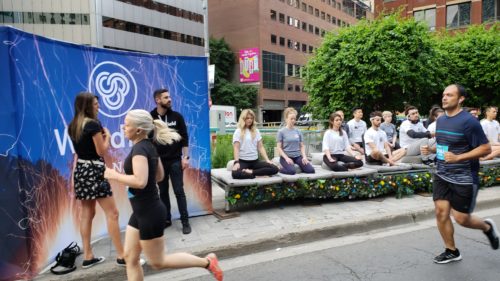
OMMMMMMMM
At the 1km mark we ran by a group meditating. While I am the type that needs pumping up rather than slowing down, I thought it was a great way to reinforce to participants that we need to focus on breathing early on in the run.
RUNNING THROUGH THE 6 (WITH MY GIANT INFLATABLE CHEERLEADERS)
As we continued on the course and started approaching the CN tower I was really savoring how special it was to be running through our beautiful city…
And immediately forgot all of that after spotting these in the distance:
Whoever thought that including inflatable dancers on the course would be a good idea was absolutely correct and I thank you for providing me with this laugh out loud moment.
These always remind me of the It’s Always Sunny in Philadelphia episode where Dee is dancing with one on a boat:
If you feel inspired to try those moves yourself, make sure you stretch first!
Here is another pic of them from a closer angle just because I love them so much.
EASY RIDERS
Approaching the 5k mark was a group of people on stationary bikes from Ride Cycle Club, a gym in Toronto. And when I say “people” I mean… I am pretty sure they are all professional models that were hired to cheer for us. Paid or not, it felt good to get attention and motivation from such beautiful people. Why yes — yes, I will keep running!
RUN TO CARBS
Although I was only about half way through the run, I could see the finish line on the other side of the road. Do you feel it is motivating to see others finish? Or does it just remind you how far you still have to go – and that you are slow? I am definitely in the second category, although really welcomed the distraction of watching people finish — good for them! It was also a chance for me to take a peek at all of the fun items being handed out after completion…like the display of giant pretzels! Consider me motivated! I’m coming for you, pretzels!
DOGGED DETERMINATION
While I love salty snacks, had I known this cutie was only a short distance away I would have been even more fired up!
This pup may have looked pooped but his festive wear was screaming of excitement. Best. Cheerleader. Ever. Please everyone, if you have a pet, bring them to a race to cheer people on! You can’t NOT get a smile with one of these little guys by your side. Just TOO cute!
STREET TREATS
While running along Lakeshore, I was once again distracted by how fun it is to run on roads in organized races!
Will I ever get over it?
No, I don’t think so.
We aren’t supposed to be there! THEY ARE FOR CARS!

FINISH LINE
This was enough of a thrill to get me through to the end of the race, even so much so that I forgot to get a picture of the finish line.
But who doesn’t love this moment!?
I’m not crying, you’re crying!!!
The idea of getting rid of race medals came up in the iRun running group on Facebook (are you a member yet?), but I have only done two other races with medals so they are still pretty exciting to me and I loved this moment!
Also I am so glad to be finished because that means it’s PRETZEL TIME! And boy did it deliver!!! Not only in taste but storytelling as well: the man who handed me my pretzel said that they were courtesy of Drake and Raptors’ All-Star Demar DeRozan. Essscusee? Can anyone fact check this?.
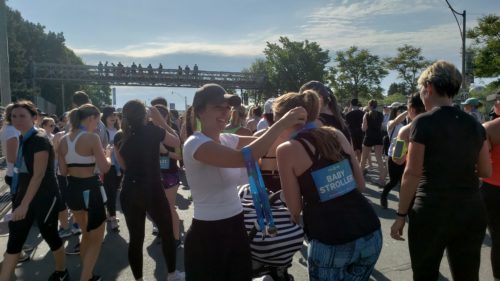
PARTY TIME
Lululemon promised us an after-party and I couldn’t wait to see what was in store.
Adorable start!
Next up, this cool photo wall! People DO love an instagram photo-opp and there was a long line to prove it!
The after party was filled with vendors, post run luxuries like massages, drinks, etc. but the main attraction: giant yoga session!
This is the most people I have ever seen participate in yoga at one time, but maybe I don’t hang out where you do, and this is perfectly normal.
Also note the large canvases on either side of the stage, where artists were creating live masterpieces.
Cool! Also, good form, yoga lady!
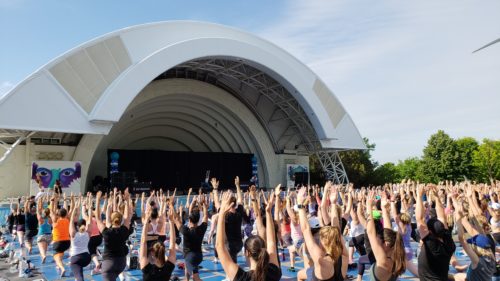
Since I am not the yoga type and more of the free sample type, I quickly moved on to the KIND bar tent. I love these things! Not only were they sampling two of their latest bars, but they were giving away gerbera daisies for free. Yes, FREE gerbera daisies! In so many colours!! People were going nuts for them, so I got right in there and picked myself some beauties to take home.
These flowers are about $10 each at the flower shop near my house — $10! So this was an absolute thrill (you know you’re old when…). Thanks KIND!!!!
If that wasn’t enough excitement for one day, guess who was behind me at the Saucony tent?! Krista DuChene, taking pictures with fans! How cool! This woman is a true inspiration.
Before heading out, I spotted a girl with a sign that I had seen while running the course and had to get a pic:
Also props to the guy with the sign that read “Motivational slogan”. Thank you sir, and keep being you’re inspiring self.
Welp, I’m out of pictures so I suppose that ends my recap of this awesome event!
Did you run the race? What was YOUR favourite part?





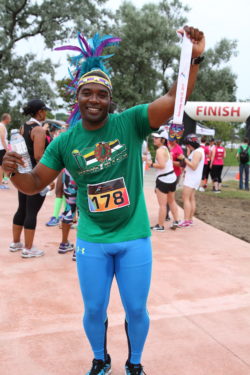
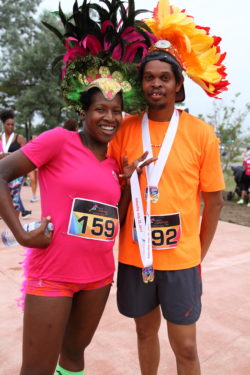





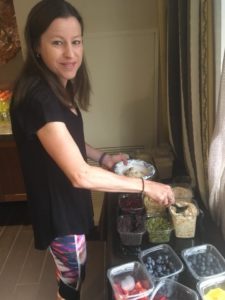 Wednesday
Wednesday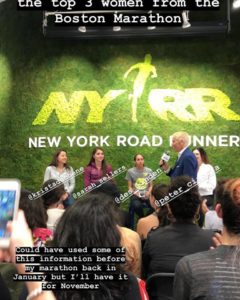 Saturday
Saturday
 Our Magazine
Our Magazine
